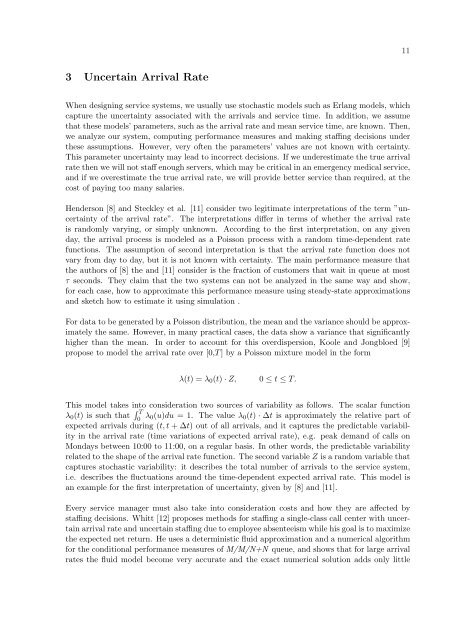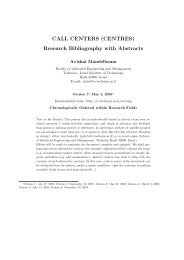Uncertainty in the Demand for Service - Faculty of Industrial ...
Uncertainty in the Demand for Service - Faculty of Industrial ...
Uncertainty in the Demand for Service - Faculty of Industrial ...
You also want an ePaper? Increase the reach of your titles
YUMPU automatically turns print PDFs into web optimized ePapers that Google loves.
3 Uncerta<strong>in</strong> Arrival Rate<br />
When design<strong>in</strong>g service systems, we usually use stochastic models such as Erlang models, which<br />
capture <strong>the</strong> uncerta<strong>in</strong>ty associated with <strong>the</strong> arrivals and service time. In addition, we assume<br />
that <strong>the</strong>se models’ parameters, such as <strong>the</strong> arrival rate and mean service time, are known. Then,<br />
we analyze our system, comput<strong>in</strong>g per<strong>for</strong>mance measures and mak<strong>in</strong>g staff<strong>in</strong>g decisions under<br />
<strong>the</strong>se assumptions. However, very <strong>of</strong>ten <strong>the</strong> parameters’ values are not known with certa<strong>in</strong>ty.<br />
This parameter uncerta<strong>in</strong>ty may lead to <strong>in</strong>correct decisions. If we underestimate <strong>the</strong> true arrival<br />
rate <strong>the</strong>n we will not staff enough servers, which may be critical <strong>in</strong> an emergency medical service,<br />
and if we overestimate <strong>the</strong> true arrival rate, we will provide better service than required, at <strong>the</strong><br />
cost <strong>of</strong> pay<strong>in</strong>g too many salaries.<br />
Henderson [8] and Steckley et al. [11] consider two legitimate <strong>in</strong>terpretations <strong>of</strong> <strong>the</strong> term ”uncerta<strong>in</strong>ty<br />
<strong>of</strong> <strong>the</strong> arrival rate”. The <strong>in</strong>terpretations differ <strong>in</strong> terms <strong>of</strong> whe<strong>the</strong>r <strong>the</strong> arrival rate<br />
is randomly vary<strong>in</strong>g, or simply unknown. Accord<strong>in</strong>g to <strong>the</strong> first <strong>in</strong>terpretation, on any given<br />
day, <strong>the</strong> arrival process is modeled as a Poisson process with a random time-dependent rate<br />
functions. The assumption <strong>of</strong> second <strong>in</strong>terpretation is that <strong>the</strong> arrival rate function does not<br />
vary from day to day, but it is not known with certa<strong>in</strong>ty. The ma<strong>in</strong> per<strong>for</strong>mance measure that<br />
<strong>the</strong> authors <strong>of</strong> [8] <strong>the</strong> and [11] consider is <strong>the</strong> fraction <strong>of</strong> customers that wait <strong>in</strong> queue at most<br />
τ seconds. They claim that <strong>the</strong> two systems can not be analyzed <strong>in</strong> <strong>the</strong> same way and show,<br />
<strong>for</strong> each case, how to approximate this per<strong>for</strong>mance measure us<strong>in</strong>g steady-state approximations<br />
and sketch how to estimate it us<strong>in</strong>g simulation .<br />
For data to be generated by a Poisson distribution, <strong>the</strong> mean and <strong>the</strong> variance should be approximately<br />
<strong>the</strong> same. However, <strong>in</strong> many practical cases, <strong>the</strong> data show a variance that significantly<br />
higher than <strong>the</strong> mean. In order to account <strong>for</strong> this overdispersion, Koole and Jongbloed [9]<br />
propose to model <strong>the</strong> arrival rate over [0,T ] by a Poisson mixture model <strong>in</strong> <strong>the</strong> <strong>for</strong>m<br />
λ(t) = λ0(t) · Z, 0 ≤ t ≤ T.<br />
This model takes <strong>in</strong>to consideration two sources <strong>of</strong> variability as follows. The scalar function<br />
λ0(t) is such that T<br />
0 λ0(u)du = 1. The value λ0(t) · ∆t is approximately <strong>the</strong> relative part <strong>of</strong><br />
expected arrivals dur<strong>in</strong>g (t, t + ∆t) out <strong>of</strong> all arrivals, and it captures <strong>the</strong> predictable variability<br />
<strong>in</strong> <strong>the</strong> arrival rate (time variations <strong>of</strong> expected arrival rate), e.g. peak demand <strong>of</strong> calls on<br />
Mondays between 10:00 to 11:00, on a regular basis. In o<strong>the</strong>r words, <strong>the</strong> predictable variability<br />
related to <strong>the</strong> shape <strong>of</strong> <strong>the</strong> arrival rate function. The second variable Z is a random variable that<br />
captures stochastic variability: it describes <strong>the</strong> total number <strong>of</strong> arrivals to <strong>the</strong> service system,<br />
i.e. describes <strong>the</strong> fluctuations around <strong>the</strong> time-dependent expected arrival rate. This model is<br />
an example <strong>for</strong> <strong>the</strong> first <strong>in</strong>terpretation <strong>of</strong> uncerta<strong>in</strong>ty, given by [8] and [11].<br />
Every service manager must also take <strong>in</strong>to consideration costs and how <strong>the</strong>y are affected by<br />
staff<strong>in</strong>g decisions. Whitt [12] proposes methods <strong>for</strong> staff<strong>in</strong>g a s<strong>in</strong>gle-class call center with uncerta<strong>in</strong><br />
arrival rate and uncerta<strong>in</strong> staff<strong>in</strong>g due to employee absenteeism while his goal is to maximize<br />
<strong>the</strong> expected net return. He uses a determ<strong>in</strong>istic fluid approximation and a numerical algorithm<br />
<strong>for</strong> <strong>the</strong> conditional per<strong>for</strong>mance measures <strong>of</strong> M/M/N+N queue, and shows that <strong>for</strong> large arrival<br />
rates <strong>the</strong> fluid model become very accurate and <strong>the</strong> exact numerical solution adds only little<br />
11
















